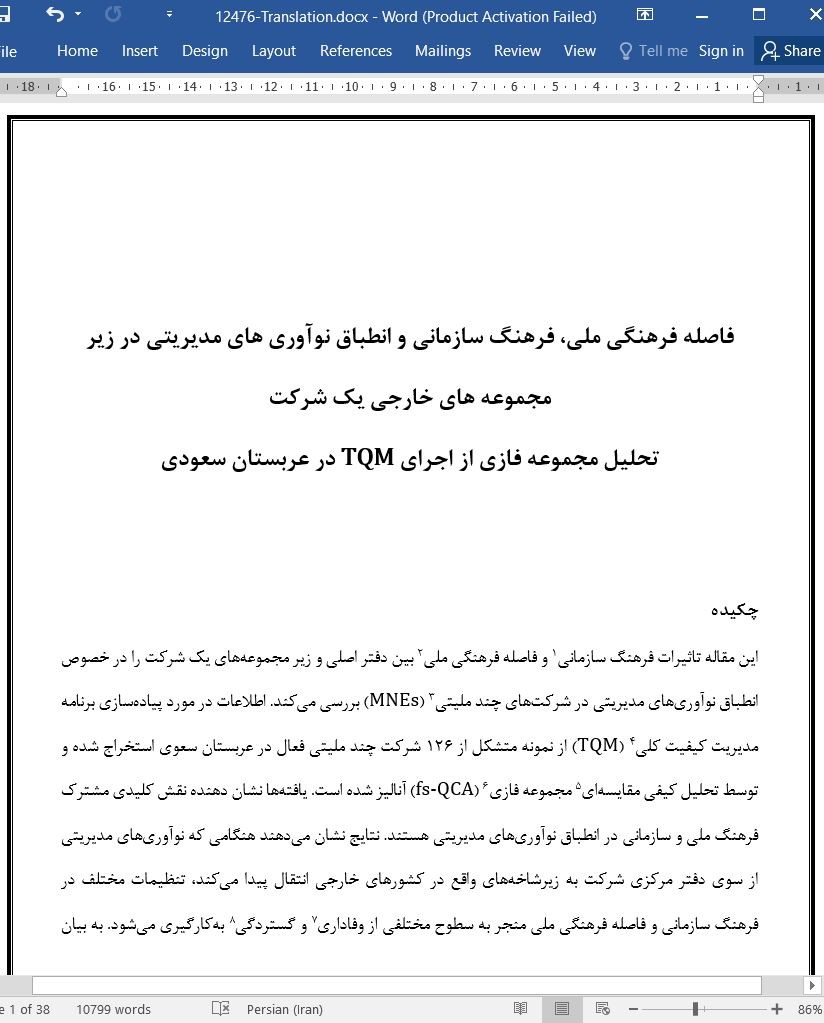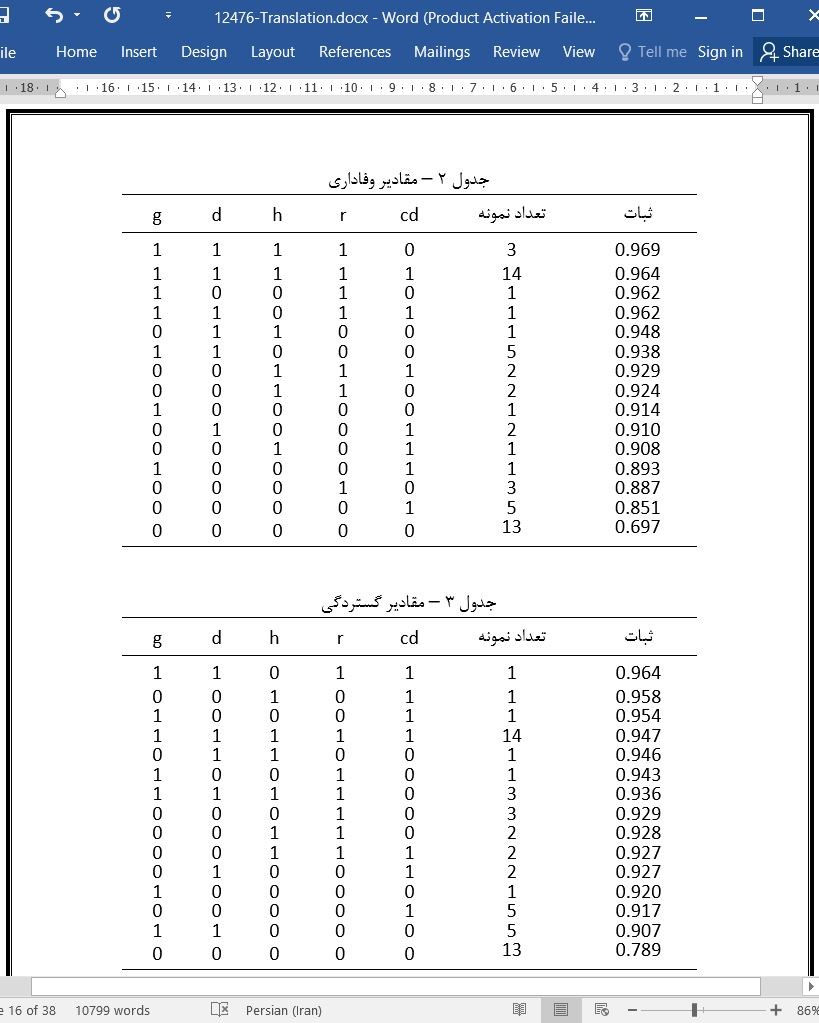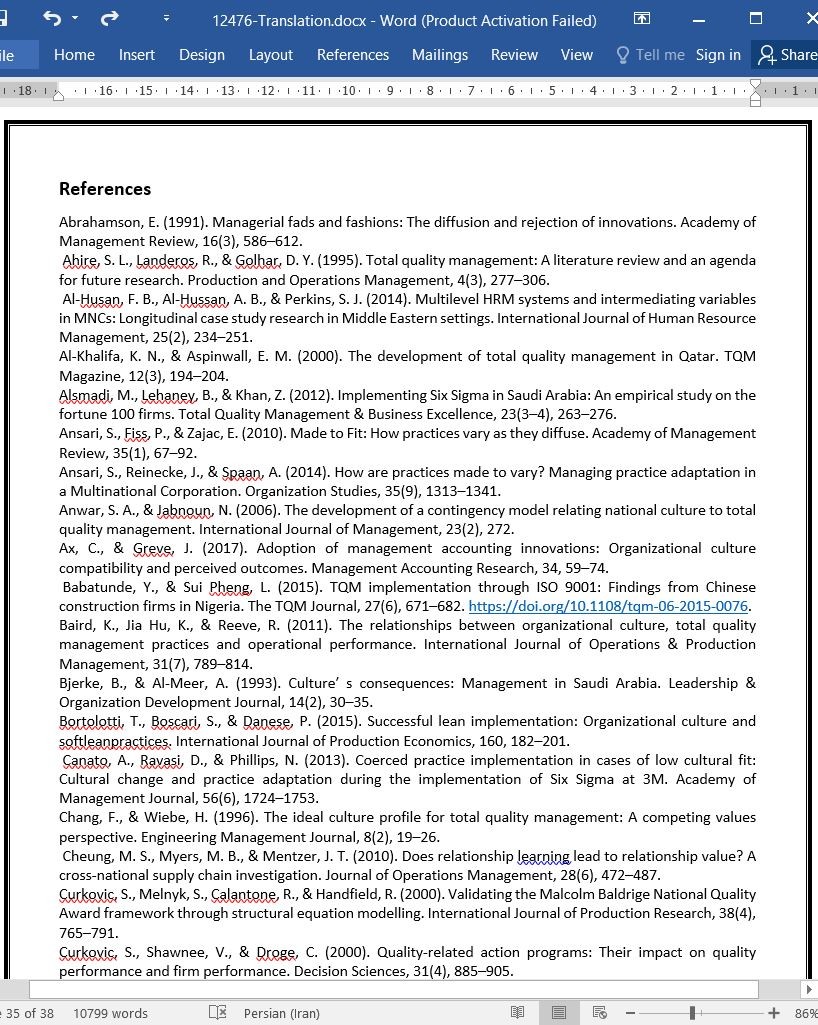
دانلود مقاله فاصله فرهنگی ملی، فرهنگ سازمانی و انطباق نوآوری های مدیریتی در زیر مجموعه های خارجی یک شرکت
چکیده
این مقاله تاثیرات فرهنگ سازمانی و فاصله فرهنگی ملی بین دفتر اصلی و زیر مجموعههای یک شرکت را در خصوص انطباق نوآوریهای مدیریتی در شرکتهای چند ملیتی (MNEs) بررسی میکند. اطلاعات در مورد پیادهسازی برنامه مدیریت کیفیت کلی (TQM) از نمونه متشکل از 126 شرکت چند ملیتی فعال در عربستان سعوی استخراج شده و توسط تحلیل کیفی مقایسهای مجموعه فازی (fs-QCA) آنالیز شده است. یافتهها نشان دهنده نقش کلیدی مشترک فرهنگ ملی و سازمانی در انطباق نوآوریهای مدیریتی هستند. نتایج نشان میدهند هنگامی که نوآوریهای مدیریتی از سوی دفتر مرکزی شرکت به زیرشاخههای واقع در کشورهای خارجی انتقال پیدا میکند، تنظیمات مختلف در فرهنگ سازمانی و فاصله فرهنگی ملی منجر به سطوح مختلفی از وفاداری و گستردگی بهکارگیری میشود. به بیان روشنتر، یافتههای ما نشان میدهند که سطح بالایی از فاصله فرهنگی ملی لزوما مانعی بر سر راه انتقال نوآوریهای مدیریتی در داخل یک شرکت چند ملیتی نیست و فرهنگ سازمانی میتواند تاثیرات ناشی از فاصله فرهنگی ملی را متعادلسازی نماید.
1. مقدمه
باور بر این است که نوآوری مدیریتی یکی از مهمترین منابع برتری رقابتی برای شرکتها (هامل، 2006) به شمار میرود و در مورد شرکتهایی که قصد دارند بازده و رقابتپذیری خود را در مقیاس جهانی ارتقاء دهند، از اهمیت بیشتری برخوردار است. در تبعیت از آثار تحقیقاتی مول و برکینشاو (2009)، ما نیز نوآوری مدیریتی را «وارد کردن اصول مدیریتی جدید به شرکت (سازمان) با هدف ارتقای عملکرد آن» تعریف میکنیم. اغلب مطالعات پیشین بر جنبههای مختلف انطباق نوآوریهای مدیریتی (برای مثال آبراهامسون، 1991) تمرکز داشته و انتقال موفق آن را همزمان با انطباق روش میدانند. با این حال، راجرز (2003) عقیده دارد تکنولوژی جدید یا نوآوریهای مدیریتی به طور معمول در همان شکل اصلی خود توسط شرکتها بهکار گرفته نمیشوند، بلکه در فرآیند انتقال توسط شرکت تغییر یافته یا «منطبق» میشوند. به بیان دیگر، احتمال دارد در عین انطباق، به کار گرفته شوند. انصاری، فریس و زاجاک (2010) انطباق نوآوریهای مدیریتی را «فرآیندی که توسط آن انطباق دهنده در تلاش است تا سازگاری بهتری بین روش خارجی و نیازهای به خصوص تطبیق دهنده جهت افزایش محدوده مقبولیت در حین اجرا» تعریف میکنند. در این مقاله ما نحوه تاثیرگذاری فرهنگ سازمانی، به همراه فاصله فرهنگی ملی بین شعبه مرکزی و شرکتهای تابعه را بر هر دو مقوله به کار گیری و انطباق نوآوریهای مدیریتی منتقل شده داخل شرکتهای چند ملیتی بررسی میکنیم.
5.3. محدودیتها و تحقیقات آتی
واضح است محدودیتهایی در مطالعات و یافتهها ما وجود دارد که میتوان آنها را فضایی برای انجام تحقیقات آتی دانست. مواردی از قبیل مطالعه بیشتر در خصوص تاثیرات فاصله فرهنگی ملی و فرهنگهای سازمانی در انتقال روشهای مدیریتی در MNEها از جمله اینها هستند. نظیر هر پژوهش دیگر، پژوهش ما نیز محدود به داده موجود بوده و یافتههای ما نیز تمامی تاثیرات ناشی از سایر فاکتورهایی که در بررسی آنها ناتوان بودیم را شامل نمیشود. یکی از محدودیتهای پژوهش ما دشواری در دسترسی به داده است. ما تنها پیادهسازیهای TQM صورت گرفته در شرکتهای تابعه MNEها واقع در عربستان سعودی را بررسی کردهایم و چنین فرض کردهایم که TQM با اتخاذ بهترین روشها در دفتر مرکزی اجرا شده است. تحقیقات آتی میتواند مربوط به تلاش برای دریافت داده در دفاتر مرکزی و شرکتهای زیر مجموعه در سایر کشورها باشد. به خاطر محدودیتهای زمانی، تنها در یک برهه از زمان توانستیم از شرکتها داده جمع آوری کنیم، پس در بررسی تغییرات در رویههای اتخاذ شده در شرکتها در طول زمان ناتوان بودهایم. در صورت وجود چنین دادهای تحقیقات بیشتر در خصوص این سوال ممکن خواهد شد. تستهای پایداری انجام شده با استفاده از زیر-ابعاد معیارهای WVS و معیارهای هوفستد از فرهنگ نشان دهنده نتایجی هستند که بسته به ابعاد فرهنگی ملی و معیارهای متفاوت به کار رفته، میتوانند تغییر کنند، که خود نشان دهنده نیاز به مطالعات آتی برای توجه بیشتر به زیر-ابعاد فرهنگ ملی و معیارهای به کار رفته است.
Abstract
This paper examines the effects of organizational culture and national cultural distance between the headquarters and the subsidiary on the adaptation of management innovations in multinational enterprises (MNEs). Data on Total Quality Management (TQM) implementations were collected from a sample of 126 MNEs operating in Saudi Arabia and analyzed using fuzzy-set qualitative comparative analysis (fs-QCA). The findings highlight the critical roles that national and organizational cultures jointly play in the adaptation of a management innovation. The results suggest that different configurations of organizational culture and national cultural distance result in different levels of fidelity and extensiveness of the implementation when management innovations are transferred from MNE headquarters to subsidiaries. More specifically, our findings show that a greater level of national cultural distance is not necessarily a barrier to the transfer of a management innovation within an MNE and that the organizational culture can offset the effect of national cultural distance.
1. Introduction
Management innovation has been argued to be one of the most important and sustainable sources of competitive advantage for firms (Hamel, 2006) and is an increasingly important issue for firms as they seek to improve their productivity and competitiveness in the face of global competition. Following Mol and Birkinshaw (,p.)1269, 2009, we define management innovation as “the introduction of management practices that are new to the firm and intended to enhance firm performance”. Most previous studies have focused on various aspects of adoption of management innovations (e.g. Abrahamson, 1991); and consider successful transfer to have taken place when the practice is adopted. However, Rogers (2003) suggests that new technology or management innovations are not usually adopted in their original form by organizations but altered or “adapted” by organizations in the transfer process. In other words, they are likely to be both adapted and adopted. Ansari, Fiss, and Zajac (2010, p.71) define the adaptation of management innovations as “the process by which an adopter strives to create a better fit between an external practice and adopter’s particular needs to increase its ‘zone of acceptance’ during implementation”. In this paper, we examine how organizational culture, as well as national cultural distance between the headquarters and the subsidiary, affect both the adoption and the adaptation of management innovations transferred within MNEs.
5.3. Limitations and further research
Clearly, there are limitations in our study and our findings should be seen as an exploratory first step towards further research on the effects of national cultural distance and organizational cultures on the transfer of management practices in MNEs. Like any study, our study is limited by the data available and our findings do not preclude the possible effects of other factors that we were unable to examine. One limitation of our study is that owing to difficulties in data access, we only examined TQM implementations in the Saudi Arabian subsidiaries of MNEs and we assumed that TQM was implemented in the headquarters according to best practices. Future research might attempt to collect data in the headquarters and subsidiaries in different countries. Owing to time limitations, we were also only able to collect data from each company at one point in time, so we were unable to examine the potential changes in practices and organizational culture that happen over time. Future research might examine this question where such data is available. The robustness tests we carried out using subdimensions of the WVS measures and the Hofstede measures of culture also showed that the results may vary depending on the different national culture dimensions and measures that are used, highlighting the need in future studies to pay more attention to the subdimensions of national culture and the measures used.
چکیده
1. مقدمه
2. مرور ادبیات
2.1. به کار گیری و انطباق نوآوریهای مدیریتی
2.2. نقش فاصله فرهنگی ملی در انطباق نوآوریهای مدیریتی
2.3. فرهنگ سازمانی و «تناسب» آن در انطباق نوآوریهای مدیریتی
2.4. انتقال TQM به عنوان نوآوری مدیریتی
3. روششناسی
3.1. حوزه تحقیق
3.2. نمونه
3.3. تحلیل پیکربندی
3.4 متغیرها
3.4.1. وفاداری و گستردگی انتقال روش
3.4.2 فاصله فرهنگی ملی
3.4.3. تناسب فرهنگی سازمان
3.5. تحلیل
3.5.1. کالیبراسیون داده
3.5.2. تحلیل شرایط لازم
3.5.3. تحلیل شرایط کافی
3.5.4. تحلیل محافظه کار مقادیر برای وفاداری
3.5.5. تحلیل محافظهکار جدول مقادیر گستردگی
3.5.6 تستهای پایداری
4. بحث
5. نتیجه گیری
5.1. پیامدهای نظری
5.2. پیامدهای عملی
5.3. محدودیتها و تحقیقات آتی
منابع
ABSTRACT
1. Introduction
2. Literature review
2.1. Adoption and adaptation of management innovations
2.2. The role of national culture distance in the adaptation of management innovations
2.3. Organizational culture and its “fit” in the adaptation of management innovation
2.4. The transfer of TQM as a management innovation
3. Methodology
3.1. Research context
3.2. The sample
3.3. Configurational analysis
3.4. Variables
3.4.1. Fidelity and extensiveness of practice transfer
3.4.2. National cultural distance
3.4.3. Organizational cultural fit
3.5. Analysis
3.5.1. Data calibration
3.5.2. Analysis of necessary conditions
3.5.3. Analysis of sufficient conditions
3.5.4. Conservative analysis of truth table for fidelity
3.5.5. Conservative analysis of truth table for extensiveness
3.5.6. Robustness tests
4. Discussion
5. Conclusion
5.1. Theoretical implications
5.2. Practical implications
5.3. Limitations and further research
References
- اصل مقاله انگلیسی با فرمت ورد (word) با قابلیت ویرایش
- ترجمه فارسی مقاله با فرمت ورد (word) با قابلیت ویرایش، بدون آرم سایت ای ترجمه
- ترجمه فارسی مقاله با فرمت pdf، بدون آرم سایت ای ترجمه



